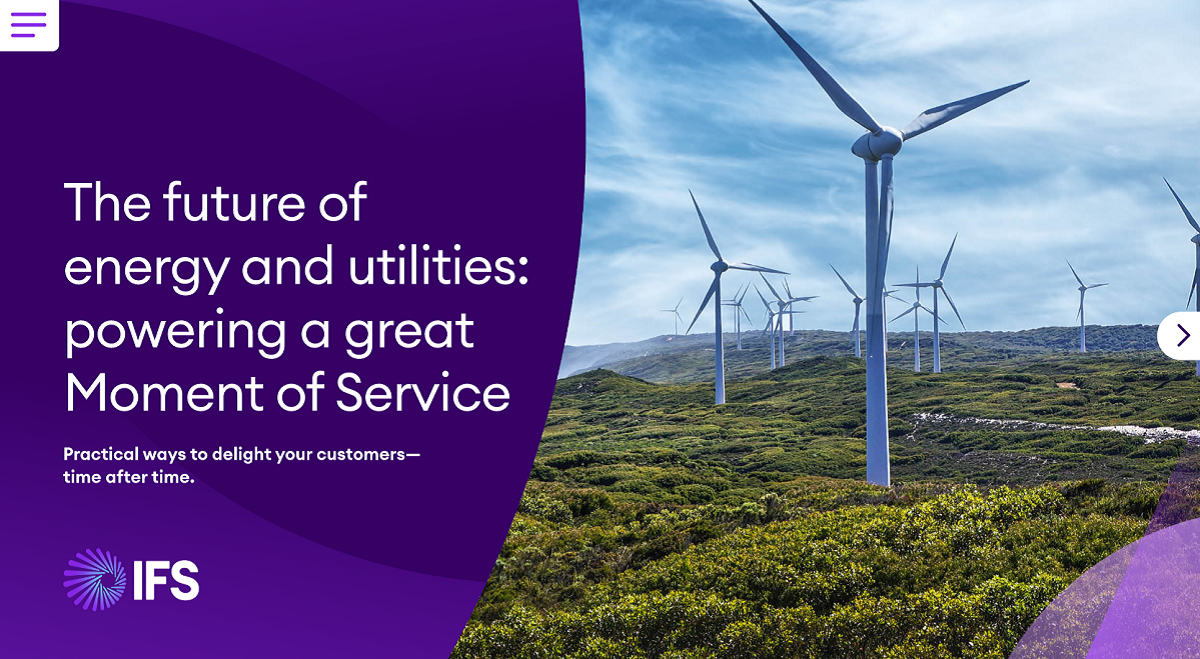Arguably, no organizations face such radical and transformative change as those currently operating within the energy and utilities sectors.
Fueled (rightly) by unrelenting global political and societal pressure, the need to move rapidly to environmentally sustainable business models is, in many cases, prompting total reinvention. With utilities currently accounting for an estimated 25 percent of global CO2 production, climate change and decarbonization is top of the agenda.
In parallel, to de-risk business from market volatility, energy companies must diversify their energy mix. But this also creates increasingly complex organizations, requiring agility and flexibility to maintain mixed assets across different generation platforms and geographies. It is enabling organizations to meet these challenges that has informed the way IFS Cloud, the latest solution release from IFS, supports delivery across critical Moments of Service in the customer lifecycle.

Square peg, round hole?
Transmission system operators are wrestling with the challenges of renewable generation. Current grids were designed to accommodate power entry from a small number of locations, not diverse, distributed sources. As consumers and suppliers invest in distributed energy resources like domestic solar/wind generating excess capacity, so the need to manage two-way power exchange in a service-centric operation grows.
Increasingly, customers are taking energy matters into their own hands. ‘Behind the meter’ power generation is on the rise, as households and industry are turning to solar photovoltaic panels and geothermal systems to augment their energy supply. Introducing such distributed energy resources (DERs) from renewables to supply the grid means managing many OEM relationships and sharing data held in different systems. Yet these multi-disciplinary joint ventures and partnerships must also integrate with the brand’s ability to offer a coherent customer experience. It’s not easy: when problems or outages arise, the consumer interaction and experience with call center agents and field service technicians is central to building loyalty. In a highly competitive market, leadership rests on providing timely, first-time-fix service appointments, swift bill corrections and clear outage information—which are only possible with efficient internal processes and access to information.
Five areas of opportunity to deliver the Moment of Service
Confirming an inexorable shift towards greater operational and business agility, the latest IDC FutureScape report predicts that by 2024, 80 percent of electric, gas and water companies will have implemented sustainable business models by accelerating DX and rearchitecting the core business.1
Against this landscape, energy and utility organizations must find ways to deliver key Moments of Service. I can see five areas of opportunity for technology in energy and utilities, and each of these has informed our approach and functionality in the latest release of our new enterprise software solution, IFS Cloud.

Business agility
The advent of the smart meter program in the UK saw National Grid rapidly expand from its core utility activities to begin scheduling and installing domestic smart meters in the home. In this instance, it was IFS software that was ultimately able to deliver the agility, efficiency and visibility needed to effectively support what was a new company venture. Now, as society demands more sustainable solutions, providers must transition to embrace new challenges, such as charging electric vehicles or accommodating domestic generation from solar panels.
Diversification
If there’s one trait shared by successful organizations in this sector, it’s their ability to diversify their offer by accessing alternative revenue streams and adjacent markets. Hydropower and oil and gas companies are turning to alternative generation platforms such as wind and solar. BP, for example, has established an offshore wind company, whilst a Rolls-Royce Joint Venture project is building 16 modular, mini nuclear power stations across the UK, creating 21,000 jobs by 2035. Traditional providers like British Gas have created lucrative service-based propositions for gas-fired boilers and heating; they and others now face the prospect of transitioning again as we move away from gas to sustainable solar, air source and ground source heating solutions.
In addition, we can see the role of hydrogen becoming increasingly important as a green stored energy source. Forward-thinking energy companies are already looking to develop electrolysis technologies at scale to commercialize production, utilizing excess electricity from renewable generation such as wind.
Workforce and talent
The energy and utility sector potentially poses the perfect storm: an aging workforce as well as aging assets. Attracting and retaining young, new talent is a business imperative—and the industry knows it. For example, the ONS (Offshore North Sea) Conference, a biennial event in Stavanger, Norway, attracts more than 65,000 visitors and specifically hosts a dedicated hall to attract young professionals under the age of 35.
One of the associated advantages of deploying digital technology and modern software systems in the workplace is the positive impact it has on HR and recruitment. Where employees are given the right tools and UX to do their job well, everybody wins.

Innovation
Maintaining and optimizing assets and operations effectively is complex. Increasingly, systems underpinned by artificial intelligence and machine learning are providing the data, insight and visibility needed to deliver effective monitoring, failure prediction and preventative maintenance programs. And it’s not just about asset data. The recent power outage in Texas caused by storms highlights the need for providers to use meteorological data and analysis more effectively to anticipate operational risks and disruptions.
Energy providers are also being called on to find innovative ways to reduce heavy industry emissions. For instance, Europe’s largest iron ore producer, mining company LKAB, is part of a consortium that, alongside an energy company and steelmaker, is trying to produce steel in the greenest possible way. IFS enterprise asset management is supporting its data-driven mining.
Customer experience and delight
While most companies understand the importance of delivering a good customer experience, it’s about more than interaction with a call center, chatbot or web page. Managing the impact of infrastructure works is a good example. An ‘Acme Utilities apologize for any inconvenience’ road closure sign, with no works in progress for hours or days, does not reflect well on the organization or its operational planning.
In summary, most energy and utility customers currently using IFS are already producers of sustainable energy. The move to a decentralized network offers the opportunity to embed resilience and reliability within the grid: in the event of a rise in production cost or a need to a respond to an outage, producers can turn to turn to alternative renewable generation sources. IFS Cloud offers producers the visibility to manage these diverse power generation assets even more fluidly and cost-effectively, allowing seamless delivery to customers at their Moments of Service.
To learn more about how IFS can help, read our eBook: The Future of Energy & Utilities: powering a great Moment of Service

Do you have questions or comments?
We’d love to hear them so please leave us a message below.
Follow us on social media for the latest blog posts, industry and IFS news!
LinkedIn | Twitter | Facebook | Instagram
1. IDC FutureScape: Worldwide Utilities 2021 Predictions